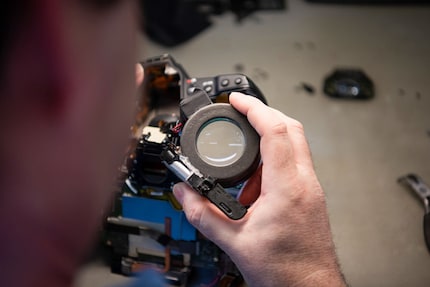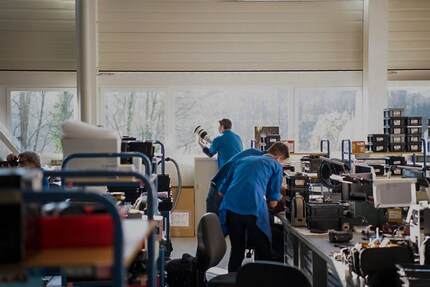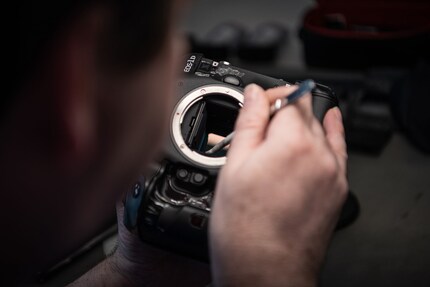
Background information
Your desk setups, part 7: Andy’s alternative workplace
by David Lee

If your camera breaks, it's sent to the service centre for repair. It's disassembled and, if possible, fixed. In our focus week about teardowns, I visited the Sertronics service centre to find out what that looks like.
In the past, Marco explains, these cameras were soldered and more difficult to open. Today, most cameras use pins, allowing him to open the camera with a special, small cross-head screwdriver.
Marco works for Sertronics and is responsible for repairing cameras. He's been working as a technician for twenty years, eleven of which he's worked in the large hall of the service centre in Birmenstorf. In all this time, he's never broken a camera – well, «at least not while I was repairing it,» he adds and laughs.
Sertronics offers various services such as repairs of almost everything that can break down, home services, workshops, various technical services and refurbishments. The company works together with digitec for warranty cases.
In the spacious Sertronics hall, the most striking thing I notice are the many televisions lined up in boxes. Damiano Randazzo, Sales and Marketing Director of Sertronics, tells me they actually repair more cameras than televisions. «It's just that TVs are so large today that it looks like so many.»
With all the camera electronics in his hand, Marco briefly explains to me what belongs to what.
The mainboard is the largest part of the back of the camera. It controls everything. When the shutter button is pressed, the camera mirror moves up and the blades open. The sensor, in this case a C-Mos, converts the light into an image via conducting paths. On the mainboard, the data is converted to a jpeg, or Raw, depending on the current setting.
On top of all the electronics, a part of the prism is visible. The mirrored prism displays the correct and upright image in the viewfinder of the camera. This technique makes the image in the viewfinder look identical to the image on the image sensor. «If you were to look through the lens only, everything would be upside down.»
After Marco has explained the camera to me so quickly that my head is spinning, he tells me about the next steps.
Now that the camera is open, Marco searches for traces of water. This is much easier than I imagined it to be: Marco looks for white stains inside the camera. The deposits are a sign that something might be defective.
The technician turns the camera around a few times and uses a magnifying glass. A few moments later, Marco finds the deposits he's looking for at the very edge of the camera. This indicates that the electronics of the camera aren't damaged. Marco doesn't find any other traces of water.
Marco tells me that he doesn't only repair cameras, but also handles some of the correspondence with the owners of the devices. They include the error descriptions of the cameras, and Marco follows up if anything is missing. He also informs customers about the next steps regarding their equipment.
«If a camera has had a fall, it's usually not in the error description. Sometimes customers aren't completely honest,» Marco says. If the flange-to-film distance has changed, it's an indication that the camera has fallen. If the technician observes this, he continues to look for damage caused by the fall.
If the camera isn't held properly, the heavy lens creates a leverage effect. This can also cause the flange-to-film distance to shift. «Once, a customer denied that this had happened. However, when the customer was on site, I saw that he held the lens and camera in the wrong way.»
Finally, Marco takes a look at the camera status protocol. «This is where most professional cameras display errors. Error codes can also be viewed on the PC.» This helps Marco to speed up the troubleshooting process. Each camera comes with a guideline of how much time processing the problem takes.
The error log of the EOS camera is empty. The camera works perfectly. Marco cleans the camera and presses a special stamp onto the sensor. He cleans the inside of the camera with cleaning alcohol.
After all this, the technician reassembles the camera. This takes slightly longer than it took him to take it apart, but I'm still impressed by Marco's skills. Before he completes the job, he takes a few test photos. And for me it's time to let the technician get back to work.
Testing devices and gadgets is my thing. Some experiments lead to interesting insights, others to demolished phones. I’m hooked on series and can’t imagine life without Netflix. In summer, you’ll find me soaking up the sun by the lake or at a music festival.
Interesting facts about products, behind-the-scenes looks at manufacturers and deep-dives on interesting people.
Show allTechnician Marco carefully opens the camera on his desk with a small screwdriver. His hand is steady as he lines up all the tiny screws of the Canon EOS-1D on the surface. Within a short time, he's removed the back panel of the camera. I can hardly keep up with what's happening. He disconnects the flex cables in no time at all. After no more than three minutes, Marco shows me the inner workings of the Canon camera.
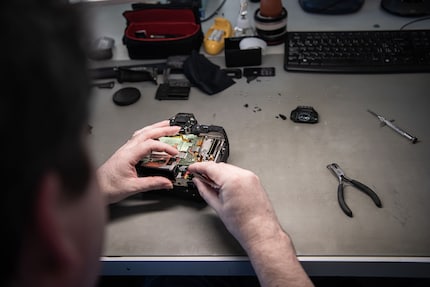
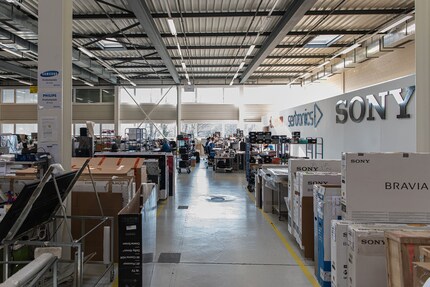
The camera that's currently on Marco's desk belongs to a professional animal photographer. Marco tells me that the French photographer, together with the camera and his huge 10,000 francs worth lens, fell into a pond. This story doesn't surprise him: he's heard much more extraordinary things in his career. After his mishap, the photographer, who lives in Alsace, took all his cameras to the service centre personally. There were four more cameras and various lenses in his camera backpack, which looks like it belongs to a skydiver.
Marco's order note says: «Check and clean». Despite its unintentional dip, the camera still works. Understandably, the photographer wants the camera to be checked for damage. Some damage is visible on the outside of the camera: the bottom corner has some scratches. Marco removes some more screws and the entire housing, starting with the cover around the display and the lower part of the camera, moving on to the upper part and the cover around the viewfinder and finishing with the front part around the sensor. At the end of it, all that's left is the inside of the camera.
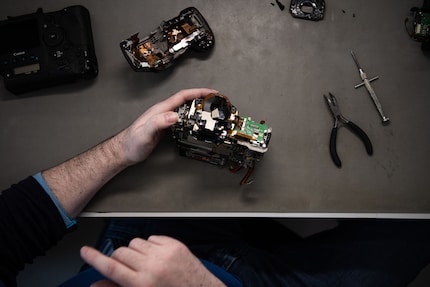

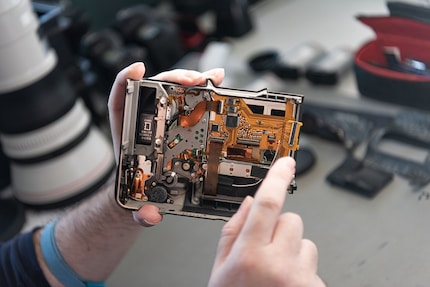
«After a fall, the contact distance is measured for control purposes», Marco continues to explain to me. The flange-to-film distance is the distance between the bayonet and the sensor. If the bayonet is pushed in or pulled out, the flange-to-film distance is impacted and the image doesn't appear focused. The technician shows me how he measures the flange-to-film distance with a laser that's precise to the micromillimeter. Again, the animal photographer was lucky: there's nothing wrong with the flange-to-film distance.
